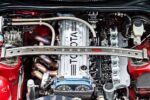When it comes to diesel engines, the catalytic converter is often a misunderstood component. Many folks think of catalytic converters as being exclusive to gasoline engines, but diesel engines have their own set of challenges and solutions when it comes to emissions. If you’re working on diesel engines, understanding the role of the catalytic converter is crucial for both performance and compliance with environmental regulations.
Catalytic Converter: The Basics
A catalytic converter is a device that reduces harmful emissions from an engine by converting harmful gases into less harmful substances. In diesel engines, this involves dealing with nitrogen oxides (NOx), carbon monoxide (CO), and particulate matter (PM). The converter uses a catalyst, typically made from precious metals like platinum, palladium, and rhodium, to facilitate these chemical reactions. It’s a vital part of the exhaust system and plays a significant role in meeting stringent emission standards.
Diesel Engine Emissions
Diesel engines are known for their fuel efficiency and torque, but they also produce higher levels of NOx and PM compared to gasoline engines. This is where the catalytic converter comes into play. In diesel applications, you’ll often encounter two types of converters: the Diesel Oxidation Catalyst (DOC) and the Selective Catalytic Reduction (SCR) system. Each serves a specific purpose in the emission control process.
Types of Catalytic Converters in Diesel Engines
- Diesel Oxidation Catalyst (DOC): Primarily used to oxidize carbon monoxide and hydrocarbons, this converter also helps in reducing particulate matter.
- Selective Catalytic Reduction (SCR): This system injects a urea solution (commonly known as diesel exhaust fluid or DEF) into the exhaust stream to convert NOx into nitrogen and water vapor.
Understanding these systems is essential for anyone working on diesel engines, whether it’s for routine maintenance or troubleshooting emissions-related issues. Knowing what each component does can save you time and headaches down the line.
Understanding the Role of the Catalytic Converter in Diesel Engines
The catalytic converter in diesel engines is a critical component that helps minimize harmful emissions while ensuring optimal engine performance. Unlike gasoline engines, where the focus is primarily on reducing hydrocarbons and carbon monoxide, diesel engines have unique challenges due to their combustion characteristics. Let’s break down the intricacies involved in diesel catalytic converters and how they work.
How Diesel Catalytic Converters Work
At the core of a diesel catalytic converter is the catalyst, which facilitates chemical reactions to convert harmful pollutants into less harmful substances. The process involves several key reactions:
- Oxidation of Carbon Monoxide and Hydrocarbons: The DOC plays a vital role here, converting CO and unburned hydrocarbons into carbon dioxide and water.
- Reduction of Nitrogen Oxides: The SCR system uses a urea-based solution to convert NOx into nitrogen and water vapor, significantly reducing harmful emissions.
Components of Diesel Catalytic Converters
Understanding the various components of a diesel catalytic converter can help mechanics and technicians diagnose issues effectively. Here’s a breakdown:
| Component | Function | Common Issues |
|---|---|---|
| Diesel Oxidation Catalyst (DOC) | Oxidizes CO and hydrocarbons | Clogging, overheating |
| Selective Catalytic Reduction (SCR) | Reduces NOx emissions | Urea injector failure, sensor issues |
| Diesel Particulate Filter (DPF) | Catches soot and particulate matter | Blockage, regeneration failure |
Importance of Maintenance
Regular maintenance is crucial for the longevity and efficiency of diesel catalytic converters. Here are some maintenance tips:
- Monitor the exhaust system for leaks or damage.
- Check the urea solution levels and quality in SCR systems.
- Inspect the DPF for soot accumulation and perform necessary regenerations.
Common Issues and Troubleshooting
Diesel catalytic converters can face various issues that can affect engine performance and emissions. Here’s a list of common problems:
- Clogging: A clogged converter can lead to increased back pressure, affecting engine power.
- Overheating: Excessive heat can damage the catalyst, leading to costly repairs.
- Sensor Failures: Faulty sensors can give inaccurate readings, leading to improper fuel management.
Legal and Environmental Considerations
With increasing environmental regulations, understanding the role of catalytic converters in diesel engines is more important than ever. Non-compliance can lead to hefty fines and damage to the environment. Diesel vehicles must meet specific emission standards, and the catalytic converter plays a pivotal role in achieving these standards.
In summary, the catalytic converter is an essential part of a diesel engine’s exhaust system. Understanding its functions, components, and maintenance needs can help mechanics ensure that diesel vehicles run efficiently and comply with environmental regulations. Regular checks and prompt troubleshooting can save time and money, keeping both the vehicle and the environment in good shape.




0 Comments